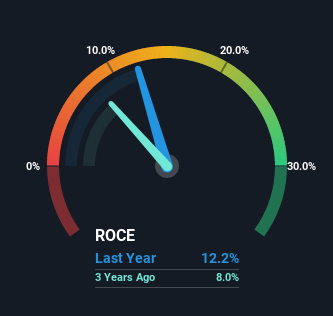
If you're looking for a multi-bagger, there's a few things to keep an eye out for. In a perfect world, we'd like to see a company investing more capital into its business and ideally the returns earned from that capital are also increasing. Basically this means that a company has profitable initiatives that it can continue to reinvest in, which is a trait of a compounding machine. Although, when we looked at Ridley (ASX:RIC), it didn't seem to tick all of these boxes.
Understanding Return On Capital Employed (ROCE)
If you haven't worked with ROCE before, it measures the 'return' (pre-tax profit) a company generates from capital employed in its business. To calculate this metric for Ridley, this is the formula:
Return on Capital Employed = Earnings Before Interest and Tax (EBIT) ÷ (Total Assets - Current Liabilities)
0.12 = AU$44m ÷ (AU$561m - AU$201m) (Based on the trailing twelve months to December 2021).
So, Ridley has an ROCE of 12%. In absolute terms, that's a satisfactory return, but compared to the Food industry average of 7.1% it's much better.
See our latest analysis for Ridley

Above you can see how the current ROCE for Ridley compares to its prior returns on capital, but there's only so much you can tell from the past. If you'd like to see what analysts are forecasting going forward, you should check out our free report for Ridley.
So How Is Ridley's ROCE Trending?
Things have been pretty stable at Ridley, with its capital employed and returns on that capital staying somewhat the same for the last five years. It's not uncommon to see this when looking at a mature and stable business that isn't re-investing its earnings because it has likely passed that phase of the business cycle. So don't be surprised if Ridley doesn't end up being a multi-bagger in a few years time. That being the case, it makes sense that Ridley has been paying out 61% of its earnings to its shareholders. If the company is in fact lacking growth opportunities, that's one of the viable alternatives for the money.
The Bottom Line
In a nutshell, Ridley has been trudging along with the same returns from the same amount of capital over the last five years. And with the stock having returned a mere 24% in the last five years to shareholders, you could argue that they're aware of these lackluster trends. As a result, if you're hunting for a multi-bagger, we think you'd have more luck elsewhere.
On a final note, we've found 1 warning sign for Ridley that we think you should be aware of.
While Ridley isn't earning the highest return, check out this free list of companies that are earning high returns on equity with solid balance sheets.
New: AI Stock Screener & Alerts
Our new AI Stock Screener scans the market every day to uncover opportunities.
• Dividend Powerhouses (3%+ Yield)
• Undervalued Small Caps with Insider Buying
• High growth Tech and AI Companies
Or build your own from over 50 metrics.
Have feedback on this article? Concerned about the content? Get in touch with us directly. Alternatively, email editorial-team (at) simplywallst.com.
This article by Simply Wall St is general in nature. We provide commentary based on historical data and analyst forecasts only using an unbiased methodology and our articles are not intended to be financial advice. It does not constitute a recommendation to buy or sell any stock, and does not take account of your objectives, or your financial situation. We aim to bring you long-term focused analysis driven by fundamental data. Note that our analysis may not factor in the latest price-sensitive company announcements or qualitative material. Simply Wall St has no position in any stocks mentioned.
About ASX:RIC
Ridley
Engages in the provision of animal nutrition solutions in Australia.
Flawless balance sheet with reasonable growth potential and pays a dividend.
Market Insights
Community Narratives


